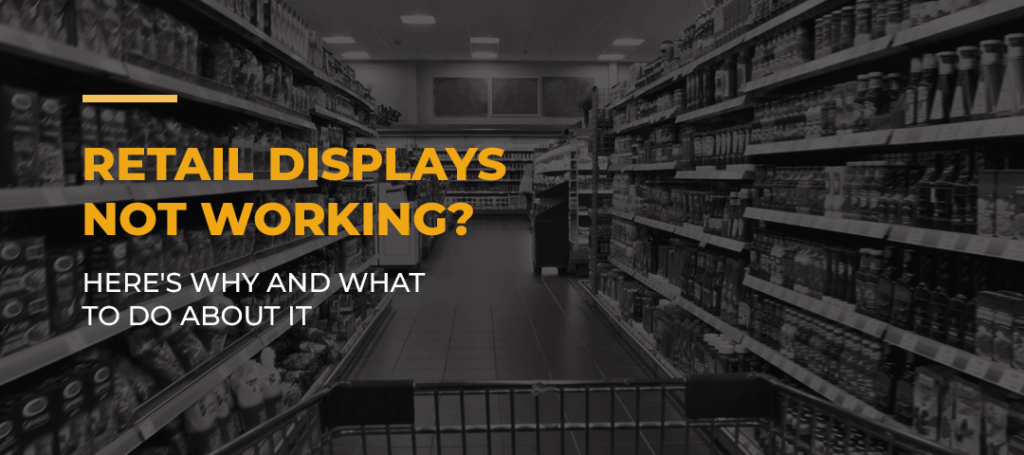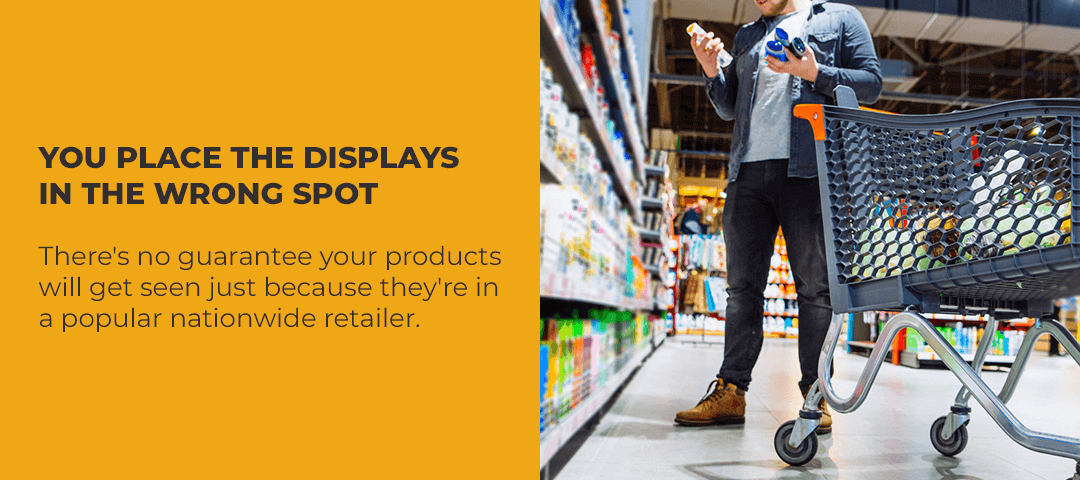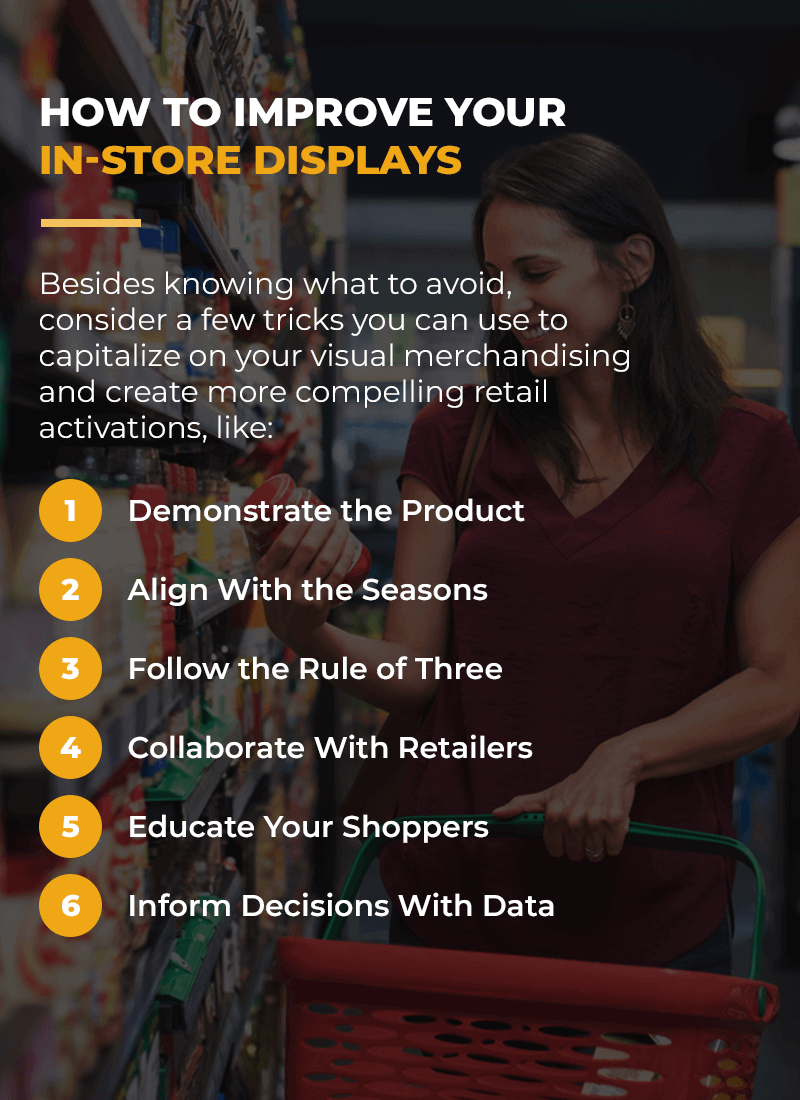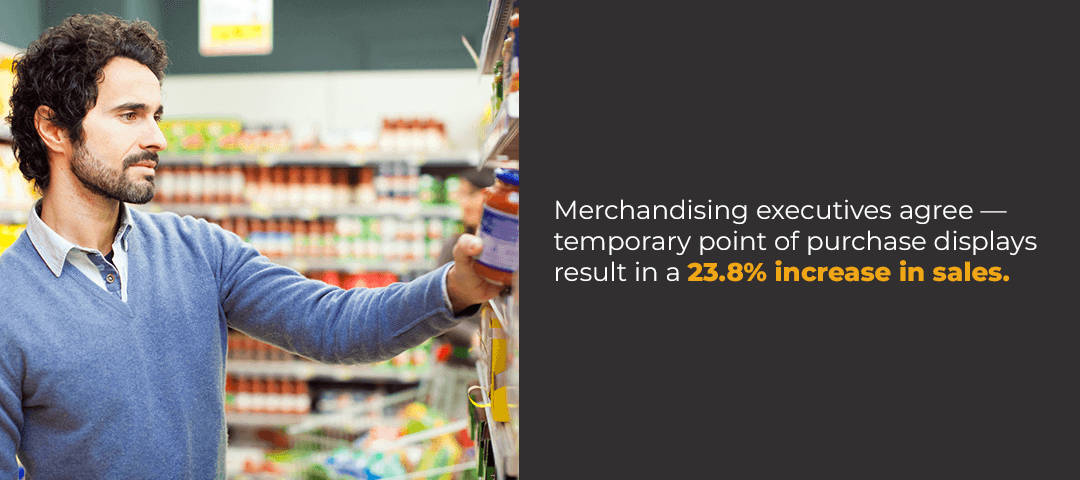
Retail displays have been around for decades. They’ve expanded from window displays to entrances and checkout lines to branded shelf space throughout the entire retail store. For many brands, in-store marketing is tried-and-true. Merchandising stands are used to increase brand awareness, encourage sales to lift, and introduce new products. If you are not experiencing the success you had hoped for with some of your recent displays, it is time to adjust your strategy. Here is what to avoid and what tactics will win more sales.
Table of Contents:
Reasons Why Your In-Store Retail Displays Aren’t Working
The biggest drawback of online shopping for 51% of consumers is not being able to feel or try a product. The second biggest con is the lack of a physical shopping experience. These needs can be met only in brick-and-mortar retail spaces and can be supercharged by using displays, which encourage product interaction. While certain products lend themselves well to online shopping, others need to create a physical connection and evoke the senses before consumers are ready to buy.
That bodes well for your in-store retail strategy because basket sizes grow when people shop in-store. One report found 71% of shoppers spend more than $50 in-store, compared to only 54% of online shoppers. What is driving those larger purchases? Impulse buys. Both men and women are more likely to add items beyond their identified needs when shopping in-store than when shopping online.
All this evidence seems to indicate that point of purchase displays are an excellent marketing opportunity. So why aren’t yours driving results? If you are struggling to find success with your in-store presentation, you could be making some critical errors that are eating into your sales potential. Knowing what to avoid can mean the difference between good versus bad visual merchandising. The top six mistakes for retail displays we see businesses make include:
1. You Use the Same Displays Year Round
Imagine a shopper who visits the same grocery store once a week. She makes the same rounds every time, purchasing similar items each week. One day, a new display arrives in the store. The shopper is very familiar with the shopping environment, so she notices when something new and attention-grabbing shows up.
Now, imagine that display stays there, showcasing the same products for an entire year. That shopper who visits every week will have seen the same marketing material roughly 52 times. The novelty and excitement wear off.
You would not broadcast the same commercial on repeat all year, and the same goes for your point of purchase displays. The variation adds new value to your products. It lets shoppers see them differently and enables you to showcase other merchandise throughout the year.
As the seasons change, so do your customers’ attitudes. A prime example is during the holidays. At that time of year, shoppers are slightly less concerned with finding necessities for themselves and more focused on checking friends and family off their gift list. A display that capitalizes on the spirit of giving or the holiday season can help you boost sales and take advantage of this shift in consumer behavior.
2. You Place the Displays in the Wrong Spot
In a retail setting, shoppers have many displays and products vying for their attention. There is no guarantee your products will get seen just because they are in a popular nationwide retailer. Some prime real estate for any in-store display is the front entrance because every shopper will pass by it. Another good location is by the register. Here, customers are stuck waiting in line, where hunger, thirst, or boredom can set in. The checkout line makes an excellent opportunity for displays involving food and other impulse buys.
When it comes to displays elsewhere in the store, it is crucial to consider your surroundings. An end-cap is an often-coveted location because shoppers are more likely to see it as they move about the store. They do not have to venture into an aisle to notice your product. It is also a good idea to think about cross-selling opportunities.
A display for kitchen utensils will drive more sales when situated near the corresponding kitchen appliances rather than somewhere else. Comparing effectiveness between locations, 37% of merchandisers say the ends of aisles are the most effective zones for driving sales, while 22.2% prefer the perimeter.
3. You Make the Displays Too Busy
Overcrowded visuals, too many products, and a lack of space between items can limit the effectiveness of a point of purchase display. Humans naturally avoid visually unappealing things, as well as messy-looking setups. Shoppers will not be convinced by a display with too many types of products or too much going on. Research from Stanford revealed only 26% of shoppers who have not made up their mind to make a purchase will be convinced by a wide selection.
In other words, too much product choice can impede impulse buys. Other shoppers may experience choice paralysis and will not complete their purchase.
Your display will likely get more mileage if you focus on one or two products per display. You could also showcase a small group of RELATED products without canceling the minimalist effect. You avoid the clutter and make it easier for your shoppers to select an option.
4. You Forgo Practicality
Will your retail partners set up your display as intended? If a design is too complicated, hard to arrange, or challenging to restock, you could cloud your brand messaging. A showcase that needs its lighting or screens can cause issues if it is not near an electrical outlet. The more complication you add, the less likely your retailers will execute it properly. One study found that 42% of in-store displays were not compliant with the advertiser’s planned display design.
Your design should be lightweight and easy to move. Always include straightforward instructions. It’s also essential to bring retailers into the conversation when designing the display and distribution plan. Ensuring your display meets big-box retailers’ requirements will also ensure that it can be placed as intended.
5. You Stick to One Dimension
While you want to err on the side of simplicity, you want your display to be dynamic and visually pleasing. A display that looks just like all the rest will have trouble standing out, so unique looks, eye-popping colors, and physical dimensions are crucial. One tactic is to use staggering heights to break up the flat shelves and draw the eye in.
Most temporary displays are constructed out of cardboard — a surprisingly versatile material. Don’t be afraid to bend or cut your structures into unique shapes for added dimension. For example, you can turn the backboard into a cardboard cutout of your product. You can also stack square or rectangular shelves on an angle or stagger some to disrupt the regular eyelines in an aisle.
6. You Exclude Customer Interaction
The best part about shopping in-store rather than online is the ability to experience products with your own eyes and hands. If you are displaying fruit, you can expect shoppers to pick them up and inspect them. If you are showing off beauty products, shoppers might uncap them to find the shade they’re looking for or test out the scent.
Build your shoppers’ natural desire to interact with their surroundings into your display. A screen with a video about the product could be all you need to help users understand a product and see it in action. You can also try using a touch screen with a personalized quiz to match customers with products.
If possible, incorporate a working product into the display, so customers can test it outside of the packaging. That’s just what we did to show off how lightweight Tidy Cats’ new litter formula was, using a built-in lift test.
How to Improve Your In-Store Displays
How can you turn your merchandising strategy toward effective retail displays? Besides knowing what to avoid, consider a few tricks you can use to capitalize on your visual merchandising and create more compelling retail activations, like:
1. Demonstrate the Product
Whether through a video or physical demo, your customers want to see your product in action. Display stands create a connection between what people see on the shelf and how it will impact their lives. Giving shoppers a way to test-drive products lets them engage with these items and see for themselves how they work. Even if this means getting a sample product out of its box for the shopper to inspect.
For example, a display for a powerful desktop fan could allow users to turn it on and off and feel the breeze on their faces. Cosmetic and perfume product displays often include a tester bottle. For those products you cannot show off, you can use videos that illustrate what the product is like in its intended environment.
2. Align With the Seasons
Besides the holidays, every season brings new messaging opportunities. The back-to-school season presents unique display options for office supplies, clothing, computers, backpacks, and other products. Your point of purchase displays can complement your latest ad campaign or call to your shoppers’ unique needs with the passing season.
3. Follow the Rule of Three
A maximum of three products will be most effective on any display. It satisfies the need for variety without venturing into the territory of clutter or choice-overload. Whatever products you display should go hand-in-hand with one another. This setup encourages cross-selling and ensures the display looks cohesive. When products follow the same theme, or one is a natural accessory to the other, this promotes the sale of both.
4. Collaborate With Retailers
A successful merchandiser needs to go beyond the brand team and align with their retail partners. Big retail chains often have their requirements for in-store displays, so it is helpful to work with structural designers who understand those parameters. When you have an out-of-the-box design in mind, it is critical to work closely with retailers to ensure they can execute what you dream up. Once the displays are up, brands rely on retailers to share insights and data about purchases resulting from the promotion.
5. Educate Your Shoppers
Many specialty items need educational content to generate demand. If a product is new and unfamiliar, customers may ignore it if they are not sure what it is or why they need one. Educational displays work well for objects like kitchen gadgets, unique technology, or any other products that are not immediately recognizable. The display can show the product in action, include text to show what it is used for, or even include interactive elements to help consumers understand the product.
Another way to use educational displays is by helping consumers see which product they need. A cosmetics merchandiser can help consumers understand how to match shades to their skin tone. A hardware display can explain what kinds of nails or screws to use for different home projects. Informative imagery, simple charts, and iconography can also make shoppers aware of the little-known benefits of a familiar product.
6. Inform Decisions With Data
Retail displays must change frequently to continue commanding shoppers’ attention. How often? The answer depends on your sales data. You should evaluate sales and product positioning weekly to drive your decisions. Ensure the most popular items are displayed most prominently and plan to change visual merchandising to something new when sales start to dip. Your point of purchase displays are your prime real estate in the retail environment, and if the items within are not selling, you need to swap them out for something that does.
Just as vital is tracking data on display execution. If your displays never make it to the sales floor, are not placed where planned or are not set up in full compliance, you will limit your sales potential. Retail experts say that if retailers improve display compliance by 1%, the retail industry will see $3 billion more in sales.
At Great Northern Instore, we have developed the Great Northern Instore Vision AppTM, a tool that lets you track compliance and collect useful data about your visual merchandising. With this data in hand, you can course-correct in real-time to maximize the sales potential of your designs.
Why Displays at Point of Purchase Add Value and Drive Results
Merchandising executives agree — temporary point of purchase displays results in a 23.8% increase in sales. According to these industry leaders, temporary exhibitions have an even greater effect on sales than permanent ones, which have a perceived 19% increase in sales.
If your retail displays are not driving the same effects, you might find this statistic hard to believe. Lots of research has gone into the retail landscape and retail displays in particular. The evidence is everywhere — when displays are done right, they have an incredible impact on sales. We have experienced that effect firsthand with many of our clients. When we developed an in-store display for Kraft, shaped like one of their iconic products, the brand saw a double-digit sales pattern over the same products sold on shelves.
Other studies have confirmed what our clients have experienced. One study regarding compact fluorescent lightbulbs found that including a sign at the point of purchase drove a 27% increase in sales, versus only a 21% increase in retail locations with no compelling signage. More statistical analysis has revealed product displays and promotional signage significantly correlate with impulse buying decisions. While ROI can vary considerably between brands and depends on effective design and implementation, the average merchandising executive attributes $2.50 in incremental sales to every $1 invested.
Humans Are Vision-Oriented
Many factors contribute to why retail displays are so persuasive. First, humans are naturally vision-oriented. Our brains process images at lightning speed, much faster than we can read. Spreads that rely on dynamic images and bright colors to convey their messaging help position those products at the forefront of shoppers’ minds. In a retail landscape, where products are often shelved alongside competitors, a display that showcases a single brand highlights it in comparison to others.
Purchase Decisions Are Made In-Store
Second, many consumer decisions happen at the moment. More and more shoppers come without shopping lists, leaving 76% of purchase decisions to be made in-store. With 68% of purchases being impulse-driven, effective retail displays are a key driver.
Displays Cater to Human Behavior
Finally, retail displays cater to consumer behavior. Many shoppers prefer quick shopping trips. Retail displays meet that desire by letting them see a product and understand its benefits quickly. Someone hunting for shampoo can spot a great deal from an island or end-cap merchandiser, pop it into the cart, and head right to checkout. Others prefer a leisurely shopping experience — retail displays aid in that too. With interactive designs and video displays, shoppers can pause to experience a product and build a connection that encourages them to buy.
Revamp Your Display Strategy and Execution With Great Northern Instore
At Great Northern Instore, we believe results are everything. Through our creative displays and data-backed designs, we’ve driven successful point of purchase displays from ideation to execution. We offer an award-winning, turnkey solution for in-store marketing, and we are already brimming with ideas for your next promotion. If you are prepared to transform your in-store strategy with great displays, reach out and let us know how we can help.











